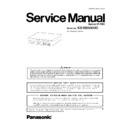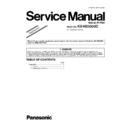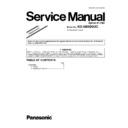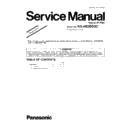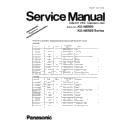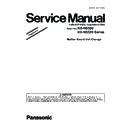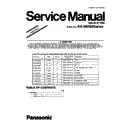Panasonic KX-NS500UC (serv.man2) Service Manual ▷ View online
2
KX-NS500UC
TABLE OF CONTENTS
PAGE
PAGE
1 Safety Precautions -----------------------------------------------4
1.1. For Service Technicians ---------------------------------4
1.2. Insulation Resistance Test -------------------------------4
1.2. Insulation Resistance Test -------------------------------4
2 Warning --------------------------------------------------------------4
2.1. Battery Caution ---------------------------------------------4
2.2. Caution--------------------------------------------------------4
2.3. About Lead Free Solder (PbF: Pb free) --------------5
2.2. Caution--------------------------------------------------------4
2.3. About Lead Free Solder (PbF: Pb free) --------------5
2.3.1. Suggested PbF Solder -------------------------------5
2.4. Discarding of P. C. Board --------------------------------5
3 Specifications ------------------------------------------------------6
3.1. General Description ---------------------------------------6
3.2. Characterstics-----------------------------------------------6
3.2. Characterstics-----------------------------------------------6
4 Technical Descriptions------------------------------------------7
4.1. Block Diagram ----------------------------------------------7
4.2. Main Unit -----------------------------------------------------9
4.2. Main Unit -----------------------------------------------------9
4.2.1. CPU Board (MPR) ------------------------------------9
4.2.2. Main Unit Mother Board --------------------------- 10
4.2.3. SLIC/CODEC (SLC) Block ------------------------ 10
4.2.4. DSP (LCOT) Block ---------------------------------- 10
4.2.5. DPT I/F Block----------------------------------------- 10
4.2.2. Main Unit Mother Board --------------------------- 10
4.2.3. SLIC/CODEC (SLC) Block ------------------------ 10
4.2.4. DSP (LCOT) Block ---------------------------------- 10
4.2.5. DPT I/F Block----------------------------------------- 10
4.3. Expansion Unit-------------------------------------------- 11
4.3.1. CPU Board (SPR) ---------------------------------- 11
4.3.2. Expansion Unit Mother Board -------------------- 12
4.3.3. SLIC/CODEC (SLC) Block ------------------------ 12
4.3.2. Expansion Unit Mother Board -------------------- 12
4.3.3. SLIC/CODEC (SLC) Block ------------------------ 12
4.4. Power Circuit ---------------------------------------------- 13
4.5. Power Supply Unit --------------------------------------- 14
4.5. Power Supply Unit --------------------------------------- 14
4.5.1. Block Diagram and Circuit Description of
PSU ----------------------------------------------------- 14
4.6. AC input, Rectification Smoothing Circuit ---------- 14
4.7. Main Converter ------------------------------------------- 15
4.8. Output voltage -------------------------------------------- 16
4.9. Battery voltage input and output---------------------- 18
4.7. Main Converter ------------------------------------------- 15
4.8. Output voltage -------------------------------------------- 16
4.9. Battery voltage input and output---------------------- 18
4.10. Alarm Signal Sending Circuit-------------------------- 19
4.11. Protection Circuit ----------------------------------------- 20
5 Location of Controls and Components ------------------ 21
5.1. Name and Locations ------------------------------------ 21
6 Installation Instructions--------------------------------------- 22
6.1. System Components ------------------------------------ 22
7 Operating Instructions ---------------------------------------- 22
7.1. System Capacity ----------------------------------------- 22
8 Test Mode ---------------------------------------------------------- 22
8.1. Utility--------------------------------------------------------- 22
9 Troubleshooting Guide---------------------------------------- 23
9.1. MPR/SPR/Mother Board ------------------------------- 23
9.1.1. Startup-------------------------------------------------- 24
9.1.2. Battery Alarm ----------------------------------------- 28
9.1.3. Using Voice Mail ------------------------------------- 29
9.1.4. Others -------------------------------------------------- 31
9.1.5. SLIC/CODEC (SLC) Block ------------------------ 31
9.1.6. DSP (LCOT) Block ---------------------------------- 31
9.1.7. DPT I/F Block----------------------------------------- 31
9.1.2. Battery Alarm ----------------------------------------- 28
9.1.3. Using Voice Mail ------------------------------------- 29
9.1.4. Others -------------------------------------------------- 31
9.1.5. SLIC/CODEC (SLC) Block ------------------------ 31
9.1.6. DSP (LCOT) Block ---------------------------------- 31
9.1.7. DPT I/F Block----------------------------------------- 31
9.2. Power Supply --------------------------------------------- 32
9.2.1. No Voltage is Output at All (1)-------------------- 32
9.2.2. No voltage is Output at All (2) -------------------- 33
9.2.3. 41V are Not Output --------------------------------- 34
9.2.4. Battery Backup Function Does Not
9.2.2. No voltage is Output at All (2) -------------------- 33
9.2.3. 41V are Not Output --------------------------------- 34
9.2.4. Battery Backup Function Does Not
Operate / PSU can Not Charge Batteries ----- 35
10 Disassembly and Assembly Instructions --------------- 36
10.1. Mother Board and CPU Board ----------------------- 36
10.2. Fan and Power Supply Board ------------------------ 37
10.2. Fan and Power Supply Board ------------------------ 37
11 Miscellaneous --------------------------------------------------- 38
11.1. How To Replace a Flat Package IC ----------------- 38
11.1.1. Preparation ------------------------------------------- 38
11.1.2. Removal Procedure -------------------------------- 38
11.1.3. Procedure--------------------------------------------- 38
11.1.4. Removing Solder From Between Pins--------- 38
11.1.2. Removal Procedure -------------------------------- 38
11.1.3. Procedure--------------------------------------------- 38
11.1.4. Removing Solder From Between Pins--------- 38
11.2. How to Replace the LLP (Leadless Leadframe
Package) IC and IC ground plate-------------------- 39
11.2.1. Preparation ------------------------------------------- 39
11.2.2. Caution ------------------------------------------------ 39
11.2.3. How to Remove the IC ---------------------------- 39
11.2.4. How to Install the IC -------------------------------- 39
11.2.5. How to Remove a Solder Bridge (Doesn't
11.2.2. Caution ------------------------------------------------ 39
11.2.3. How to Remove the IC ---------------------------- 39
11.2.4. How to Install the IC -------------------------------- 39
11.2.5. How to Remove a Solder Bridge (Doesn't
apply to IC ground plate.) ------------------------- 40
11.3. Terminal Guide of the ICs, Transistors and
Diodes ------------------------------------------------------ 41
11.3.1. Mother Board ---------------------------------------- 41
11.3.2. CPU Board ------------------------------------------- 42
11.3.3. Power Supply Board ------------------------------- 43
11.3.2. CPU Board ------------------------------------------- 42
11.3.3. Power Supply Board ------------------------------- 43
12 Schematic Diagram -------------------------------------------- 44
12.1. Mother Board --------------------------------------------- 44
12.1.1. No.1 ---------------------------------------------------- 44
12.1.2. No.2 ---------------------------------------------------- 46
12.1.3. No.3 ---------------------------------------------------- 48
12.1.4. No.4 ---------------------------------------------------- 50
12.1.5. No.5 ---------------------------------------------------- 52
12.1.6. No.6 ---------------------------------------------------- 54
12.1.7. No.7 ---------------------------------------------------- 56
12.1.2. No.2 ---------------------------------------------------- 46
12.1.3. No.3 ---------------------------------------------------- 48
12.1.4. No.4 ---------------------------------------------------- 50
12.1.5. No.5 ---------------------------------------------------- 52
12.1.6. No.6 ---------------------------------------------------- 54
12.1.7. No.7 ---------------------------------------------------- 56
12.2. Memo ------------------------------------------------------- 59
12.3. CPU Board ------------------------------------------------ 60
12.3. CPU Board ------------------------------------------------ 60
12.3.1. No.1 ---------------------------------------------------- 60
12.3.2. No.2 ---------------------------------------------------- 62
12.3.3. No.3 ---------------------------------------------------- 64
12.3.4. No.4 ---------------------------------------------------- 66
12.3.5. No.5 ---------------------------------------------------- 68
12.3.6. No.6 ---------------------------------------------------- 70
12.3.2. No.2 ---------------------------------------------------- 62
12.3.3. No.3 ---------------------------------------------------- 64
12.3.4. No.4 ---------------------------------------------------- 66
12.3.5. No.5 ---------------------------------------------------- 68
12.3.6. No.6 ---------------------------------------------------- 70
12.4. Relay Board ----------------------------------------------- 72
12.5. Memo ------------------------------------------------------- 73
12.6. Power Supply Board ------------------------------------ 74
12.7. Waveform -------------------------------------------------- 78
12.5. Memo ------------------------------------------------------- 73
12.6. Power Supply Board ------------------------------------ 74
12.7. Waveform -------------------------------------------------- 78
12.7.1. CPU Board Voltage--------------------------------- 78
12.7.2. CPU Board Reset Signal-------------------------- 81
12.7.3. CPU Board Clock ----------------------------------- 83
12.7.4. CPU Board NAND Access------------------------ 85
12.7.5. CPU Board SRAM Access ----------------------- 87
12.7.6. Power Supply Board ------------------------------- 88
12.7.2. CPU Board Reset Signal-------------------------- 81
12.7.3. CPU Board Clock ----------------------------------- 83
12.7.4. CPU Board NAND Access------------------------ 85
12.7.5. CPU Board SRAM Access ----------------------- 87
12.7.6. Power Supply Board ------------------------------- 88
13 Printed Circuit Board------------------------------------------ 89
13.1. Mother Board --------------------------------------------- 89
13.1.1. Component View ------------------------------------ 89
13.1.2. Bottom View ------------------------------------------ 90
13.1.2. Bottom View ------------------------------------------ 90
13.2. CPU Board ------------------------------------------------ 91
13.2.1. Component View ------------------------------------ 91
13.2.2. Bottom View ------------------------------------------ 92
13.2.2. Bottom View ------------------------------------------ 92
13.3. Relay Board ----------------------------------------------- 93
13.3.1. Component View ------------------------------------ 93
13.3.2. Bottom View ------------------------------------------ 93
13.3.2. Bottom View ------------------------------------------ 93
3
KX-NS500UC
13.4. Memo --------------------------------------------------------94
13.5. Power Supply Board -------------------------------------94
13.5. Power Supply Board -------------------------------------94
13.5.1. Component View-------------------------------------94
13.5.2. Bottom View-------------------------------------------95
13.5.2. Bottom View-------------------------------------------95
14 Appendix Information of Schematic Diagram ---------96
15 Exploded View and Replacement Parts List -----------97
15 Exploded View and Replacement Parts List -----------97
15.1. IC Date ------------------------------------------------------97
15.1.1. IC400 ---------------------------------------------------97
15.1.2. IC401 ---------------------------------------------------99
15.1.3. IC201 ------------------------------------------------- 101
15.1.2. IC401 ---------------------------------------------------99
15.1.3. IC201 ------------------------------------------------- 101
15.2. Cabinet and Electrical Parts ------------------------- 109
15.2.1. PSU --------------------------------------------------- 110
15.3. Accessories and Packing Materials---------------- 111
15.4. Replacement Parts List ------------------------------- 112
15.4. Replacement Parts List ------------------------------- 112
15.4.1. Cabinet and Electrical Parts -------------------- 112
15.4.2. Accessories and Packing Materials ----------- 112
15.4.3. Mother Board Parts-------------------------------- 112
15.4.4. CPU Board Parts ---------------------------------- 123
15.4.5. Power Supply Board parts----------------------- 127
15.4.2. Accessories and Packing Materials ----------- 112
15.4.3. Mother Board Parts-------------------------------- 112
15.4.4. CPU Board Parts ---------------------------------- 123
15.4.5. Power Supply Board parts----------------------- 127
16 Appendix --------------------------------------------------------- 131
4
KX-NS500UC
1 Safety Precautions
1. Before servicing, unplug the AC power cord to prevent an electric shock.
2. When replacing parts, use only the manufacturer's recommended components.
3. Check the condition of the power cord. Replace if wear or damage is evident.
4. After servicing, be sure to restore the lead dress, insulation barriers, insulation papers, shields, etc.
5. Before returning the serviced equipment to the customer, be sure to perform the following insulation resistance test to prevent
2. When replacing parts, use only the manufacturer's recommended components.
3. Check the condition of the power cord. Replace if wear or damage is evident.
4. After servicing, be sure to restore the lead dress, insulation barriers, insulation papers, shields, etc.
5. Before returning the serviced equipment to the customer, be sure to perform the following insulation resistance test to prevent
the customer from being exposed to shock hazards.
1.1.
For Service Technicians
• Repair service shall be provided in accordance with repair technology information such as service manual so as to prevent fires,
injury or electric shock, which can be caused by improper repair work.
1. When repair services are provided, neither the products nor their parts or members shall be remodeled.
2. If a lead wire assembly is supplied as a repair part, the lead wire assembly shall be replaced.
3. FASTON terminals shall be plugged straight in and unplugged straight out.
2. If a lead wire assembly is supplied as a repair part, the lead wire assembly shall be replaced.
3. FASTON terminals shall be plugged straight in and unplugged straight out.
• ICs and LSIs are vulnerable to static electricity.
When repairing, the following precautions will help prevent recurring malfunctions.
1. Cover plastic parts boxes with aluminum foil.
2. Ground the soldering irons.
3. Use a conductive mat on worktable.
4. Do not grasp IC or LSI pins with bare fingers.
2. Ground the soldering irons.
3. Use a conductive mat on worktable.
4. Do not grasp IC or LSI pins with bare fingers.
1.2.
Insulation Resistance Test
1. Unplug the power cord and short the two prongs of the plug with a jumper wire.
2. Turn on the power switch.
3. Measure the resistance value with ohmmeter between the jumpered AC plug and each exposed metal cabinet part, such as
2. Turn on the power switch.
3. Measure the resistance value with ohmmeter between the jumpered AC plug and each exposed metal cabinet part, such as
screw threads, control shafts, handle brackets, etc.
Note:
Note:
Some exposed parts may be isolated from the chassis by design. These will read infinity.
4. If the measurement is outside the specified limits, there is a possibility of shock hazard. The equipment should be repaired
and rechecked before it is returned to the customer.
2 Warning
2.1.
Battery Caution
1. Danger of explosion if battery is incorrectly replaced. Replace only with the same or equivalent type recommended by the
manufacturer. Dispose of used batteries according to the manufacturer's lnstructions.
1. The lithium battery is a critical component (type No.CR2354). Please observe for the proper polarity and the exact location
when replacing it and soldering the replacement lithium battery in.
2.2.
Caution
The power socket wall outlet should be located near this equipment and be easily accessible.
5
KX-NS500UC
2.3.
About Lead Free Solder (PbF: Pb free)
Note:
In the information below, Pb, the symbol for lead in the periodic table of elements, will refer to standard solder or solder that con-
tains lead.
We will use PbF when discussing the lead free solder used in our manufacturing process which is made from Tin, (Sn), Silver,
(Ag), and Copper, (Cu).
This model, and others like it, manufactured using lead free solder will have PbF stamped on the PCB. For service and repair
work we suggest using the same type of solder.
tains lead.
We will use PbF when discussing the lead free solder used in our manufacturing process which is made from Tin, (Sn), Silver,
(Ag), and Copper, (Cu).
This model, and others like it, manufactured using lead free solder will have PbF stamped on the PCB. For service and repair
work we suggest using the same type of solder.
Caution
• PbF solder has a melting point that is 50
~ 70 F, (30 ~ 40C) higher than Pb solder. Please use a soldering iron with tempera-
ture control and adjust it to 700
± 20 F, (370 ± 10C).
Exercise care while using higher temperature soldering irons.:
Do not heat the PCB for too long time in order to prevent solder splash or damage to the PCB.
Do not heat the PCB for too long time in order to prevent solder splash or damage to the PCB.
• PbF solder will tend to splash if it is heated much higher than its melting point, approximately 1100
F, (600C).
• When applying PbF solder to double layered boards, please check the component side for excess which may flow onto the
opposite side (See figure, below).
2.3.1.
Suggested PbF Solder
There are several types of PbF solder available commercially. While this product is manufactured using Tin, Silver, and Copper,
(Sn+Ag+Cu), you can also use Tin and Copper, (Sn+Cu), or Tin, Zinc, and Bismuth, (Sn+Zn+Bi). Please check the manufac
turer's specific instructions for the melting points of their products and any precautions for using their product with other
materials.
The following lead free (PbF) solder wire sizes are recommended for service of this product: 0.3mm, 0.6mm and 1.0mm.
(Sn+Ag+Cu), you can also use Tin and Copper, (Sn+Cu), or Tin, Zinc, and Bismuth, (Sn+Zn+Bi). Please check the manufac
turer's specific instructions for the melting points of their products and any precautions for using their product with other
materials.
The following lead free (PbF) solder wire sizes are recommended for service of this product: 0.3mm, 0.6mm and 1.0mm.
2.4.
Discarding of P. C. Board
When discarding P. C. Board, delete all personal information such as telephone directory and caller list or scrap P. C. Board.

